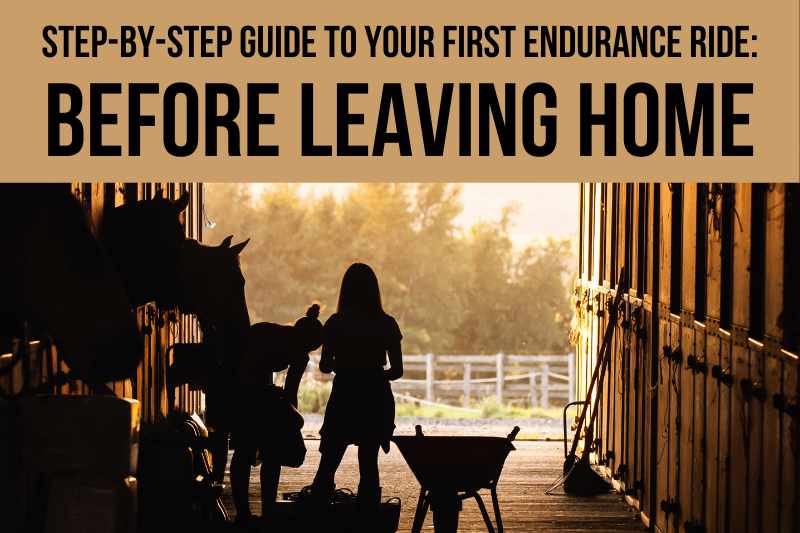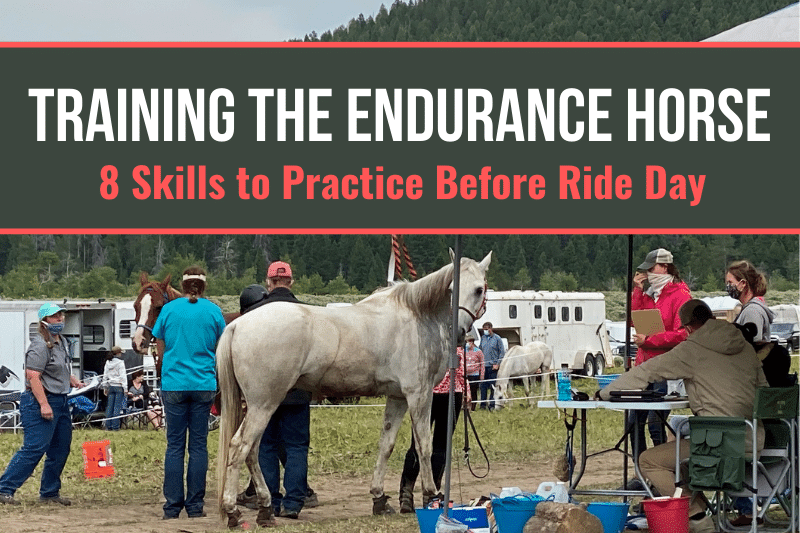Your horse is fit. You’ve picked an event. Your first equestrian endurance ride is just a few weeks away! Follow these steps to prepare for a great ride before you ever leave home.
Do Your Homework
At least two weeks out from ride day, run a mental checklist to be sure you’re prepared to follow the rules. These include:
Legal Requirements for Travel to an Endurance Ride
If you’ll be crossing state lines with your horse, you will likely need to work with your veterinarian to obtain a health certificate or certificate of veterinary inspection (CVI) and negative Coggins test.
Some ride managers will check for these documents when you register in ride camp, so you should definitely comply even if you know you won’t be driving past a government checkpoint.
Different states’ regulations vary regarding how recent a Coggins must be (usually 6 or 12 months) and how long a health certificate is good for (often 30 days). Google for details regarding the state in question, and work with your vet well ahead of time to ensure you can get an appointment and the labwork you need.
In most states, you should also have a brand inspection as proof of ownership for your horse. These usually cost about $20 and are good for as long as you continue to own the horse. To find a brand inspector, just google “horse brand inspection [state].”
Endurance Riding & Ride Camp Rules
It’s worth your while to review the rules of your ride’s sanctioning body. In the U.S., the vast majority of rides are sanctioned by the American Endurance Ride Conference, and you can read AERC’s rules here. Taking time to read (or re-read) them will increase your confidence that you know what to expect and won’t accidentally disqualify yourself.
Additionally, check whether the ride you’re going to has any specific rules for which you need to prepare. For example, many ride managers require pre-registration. Dogs may have to be on a leash. You might need weed-free hay. Some ride managers expect you to bag and haul out horse manure after the event.
Reviewing the ride’s website, flyer, and social media accounts carefully will also help you prepare for practical details like payment methods, camping fees, and potluck dinners.
Paperwork for Endurance Riding
In addition to your veterinary paperwork, make sure you have:
Driving directions – You may lose cell service on the way to camp. Also, many ride camps are off the beaten track, and it is unwise to rely on your vehicle or phone’s GPS for directions. This is a good time to go luddite and print out the ride manager’s driving directions, just in case.
Membership cards – If you are an AERC member (and you should be, to get the benefits of Endurance News and lifetime mileage tracking, as well as to avoid a $20 non-member fee), bring your ride card. Make sure you have your horse’s member number written on the back.
If you’re a member of any additional groups, like regional endurance riding clubs, take your membership cards for those as well.
I.C.E. Information – Update your In Case of Emergency information in case you get hurt at the ride. Download my free I.C.E. Pack for printable cards designed to post in your horse trailer and carry on yourself and your horse.
Prepare Your Horse
As ride day draws nearer, you need to do some things differently to make sure your horse is ready to compete.
Keep Riding (But Not Too Much)
By the time you’re two weeks out from ride day, your horse is as fit as he’s going to be for this event. Trying to squeeze a little more fitness out of one more tough workout is bound to backfire. Instead, you want to taper your horse’s workouts so he gets to ride day fresh and strong.
Do your last long ride 2 weeks before ride day. For the remainder of that week, continue with your usual conditioning schedule.
During the last week before the ride, do several rides of around 6-7 miles at a working trot. If he doesn’t get a lot of turnout, add in some easy hacks or ring work so he gets daily movement. This will help keep your horse mentally settled, as well as minimize the risk of rhabdomyolysis (tying up) that comes with leaving a fit horse standing around.
Beware Banned Substances
Double-check your horse’s supplements for any substances that are banned during AERC competition. Many supplements – and even topicals like liniments – contain banned substances like MSM, arnica, lavender, and many more.
While it’s generally fine to use these substances between rides, you need to be sure they are out of your horse’s system before the event. Remember that your horse is officially entered once you do your pre-ride vet check, typically the evening before the ride, so count back from there when calculating withdrawal times.
AERC’s website offers withdrawal time recommendations for some substances (scroll down to Appendix E on this page). However, no thorough list is available. For many substances, an exact withdrawal time is simply unknown. This puts you in the frustrating position of just doing your best in good faith. Ask your vet for advice and try to err on the safe side.
Consider Ulcer Prevention
Gastrointestinal ulcers are a widespread issue among all performance horses. Endurance horses are at particular risk because long hauling distances and extended periods of work between feedings are baked into our sport.
AERC permits a preventative dose of omeprazole during endurance rides. The only FDA-approved product available over the counter is UlcerGard. For an average-sized endurance horse, the preventative dose is ¼ tube of UlcerGard. Some riders administer one full tube daily for several days prior to ride day, then drop to the preventative dose when competing.
Additional preventative measures for equine gastric ulcers include:
- Keeping forage in the horse’s stomach as much as possible
- Including some alfalfa in the horse’s ration
- Feeding a buffer like Purina Outlast, especially before hauling or workouts
- Feeding a supplement like SmartGI Ultra or Visceral+ to support the gut’s natural healing mechanisms
- Buffering electrolytes with soothing substances like kaolin pectate and aloe
- Minimizing stress by preparing the horse mentally for travel and camping
Feed for Hydration and Energy
If you don’t already offer your horse free-choice forage, it’s a good idea to start doing so at least 3 days before the ride. Not only will roughage in the intestines help maximize your horse’s hydration potential and minimize ulcer risk, but this is the feed from which he’ll draw energy during the ride.
Try not to make significant changes to your horse’s diet before the ride, except to remove banned substances. Definitely don’t try to “carb load” with grains like you may have heard about human athletes doing. If anything, simply increase forage and consider soaking the horse’s usual ration of pellets in water to maximize water intake.
Pack Early & Pack Plenty
Packing for an endurance ride may seem easy at first glance, but it’s one of those jobs that seems to get bigger as you go. Here are some tips to get it done:
Start early – Begin packing at least a week ahead of time. This will give you time to run to the store, place Amazon orders (use this link to support this blog at no cost to you!), locate weed-free hay, and otherwise troubleshoot without last-minute stress.
Use a checklist – I don’t know about your brain, but mine isn’t big enough to hold everything I need for an endurance ride. If you don’t already have a packing list, download my free one now.
Check the weather and pack for all conditions anyway – It’s nice to know what weather conditions are likely to come your way in ride camp, but never head to a ride without being fully prepared for unexpected heat, cold, or storms. This applies not only to your own clothing, but to your horse’s tack and blankets as well.
Pack plenty – You might be surprised by how much you and your horse eat at an endurance event. It’s better to have too much than too little. This goes for other items, too. Bring extra shoes for yourself and blankets for your horse (in case they get soaked), spare tack like reins and cinch (in case they break), spare hoof boots (in case they get lost), and spare toilet paper (to share when the porta-potty runs out).
Prep As Much as Possible – Between taking care of your horse, competing, and socializing, you will be very busy from the moment you get to ride camp until the moment you leave. Reduce your stress level by preparing things ahead of time whenever possible. For example, pre-make meals that you can heat and eat rather than cooking in camp. Pre-mix your horse’s meals. Put your entire ride-day outfit in one place.
Here are some more articles to help you pack:
How to Pack Like a Pro for Your Next Endurance Ride
How to Assemble a Kickass Ride Camp Kitchen
Prepare Your Truck and Trailer
Most endurance riders wouldn’t list vehicle maintenance among their favorite activities, but it’s critical to ensure an uneventful trip to ride camp. Spend the time and money to:
- Check lights, fluids, hoses, filters, batteries, brakes, and bearings
- Check tire pressure on truck and trailer (including spares)
- Check your emergency kit for correctly sized lug-wrenches for truck and trailer, jacks, traction mats, tow straps, etc.
- Check your trailer’s safety chains and the floor beneath the mats
Getting an early start on preparing for your endurance horse ride will set you up for a smoother, less stressful event.
Check out the next posts in the Endurance Riding Step-by-Step Series:
Part 2: Step-By-Step Guide: Arriving in Ride Camp
Part 3: Step-By-Step Guide: The Evening Before
Part 4: Step-By-Step Guide: Starting Your Ride
You might also like
This post includes affiliate links, and I may earn a small commission (at no extra cost to you) when you purchase through these links. I only recommend products and services I think are helpful and useful. Thanks for helping me offset the cost of maintaining this blog as a free resource!




